All Management News
- Recovery of nutrients from wastewater June 14, 2022

Water pollution continues to be one of the serious concerns facing the country. The ensuing scenario of eutrophication and harmful algal blooms has exacerbated the menace. This demands wholescale water management techniques to segregate the pollutants, retrieve useful nutrients, and treat the water effectively for sustainable use. Dr Karthik Rajendran and his PhD scholar, Mr Sarath Chandra, from the Department of Environment Science have published a paper discussing various nutrient recovery methods and their consequential outcomes. The research was done in collaboration with Dr Deepak Kumar from SUNY College of Environmental Science and Forestry, Syracuse, NY and Dr Richen Lin from Southeast University, Nanjing, China.
The article titled, “Nutrient recovery from wastewater in India: A perspective from mass and energy balance for a sustainable circular economy” was published in Bioresource Technology Reports (Q1 Journal), having an Impact Factor of 4.41. Their research investigates the possibilities of recovering Nitrogen (N) and Phosphorous (P) from wastewater in terms of technology, energy, and economic point of view. Excessive presence of Nitrogen and Phosphorous can result in eutrophication and algal blooming. These nutrients also pose a harmful threat to infrastructure. Nutrient recovery can mitigate these challenges and improve the quality of water.
Phosphorus is one of the limited resources available on earth and a key ingredient in fertilizer production. The recovery process also helps in transforming wastewater into resource pools that can efficiently churn out valuables that hold the key to a sustainable future. This will help reduce the imports of fertilizers and bring down the emissions to half in producing fertilizers. Their findings will also pave the way for making necessary policies to reduce water pollution and recover nutrients. As two-thirds of wastewater remains uncollected, they claim that effective treatment and water management practices can save around 800 crores per annum. Their future research plan also includes the experimental analysis of the nutrient recovery system.
Abstract of the Research
Wastewater (WW) is a potential source to recover N, and P, whereas, in India, it is scarcely explored. In this work, four different nutrient recovery methods were compared from a mass- and energy-balance perspective to understand the overall process flow. From 1000-m3 WW, chemical precipitation yielded 33.8 kg struvite, while micro-algae resulted in 299.1 kg (dry powder). Energy consumption was lowest for the fuel cells at 216.2 kWh/1000 m3, while microalgae used the highest energy at 943.3 kWh/1000 m3. Nonetheless, the cost-saving analysis showed that microalgae (78.6$/1000 m3) as a nutrient recovery choice, had higher savings than any other methods compared. For a country like India, where two-thirds of urban wastewater is untreated, wastewater-biorefinery options such as nutrient recovery hold the key to a sustainable circular economy.
- We make a life by what we give June 13, 2022
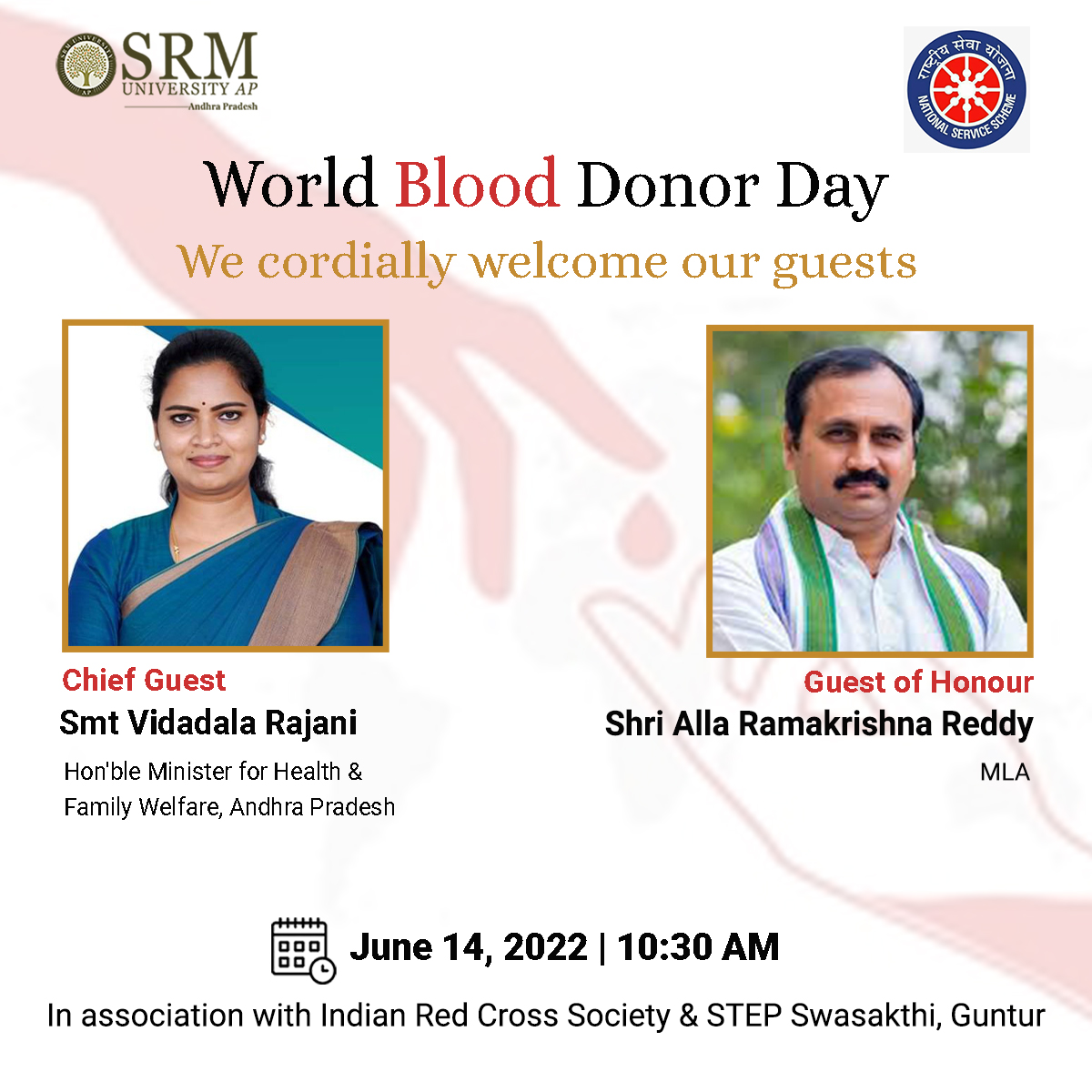
Miracles do happen if we are willing to believe in the power of giving. The World Blood Donor Day 2022 calls attention to the significance of voluntary blood donations in saving lives and enhancing solidarity within communities. The day aims to spread gratitude toward blood donors worldwide and create a broader understanding of the need for regular, unpaid blood donation. The day is an opportunity to highlight the urgency of committed and year-round blood donation to ensure adequate resources and achieve universal access.
This World Blood Donor Day, the Department of Student Affairs, in collaboration with Indian Red Cross Society and STEP, Swasakthi, Guntur celebrates the value of voluntary blood donations in improving social cohesion. Smt Vidadala Rajani, Hon’ble Minister for Health and Family Welfare, Andhra Pradesh, will be the chief guest of the day. She is one of the young and dynamic individuals who became an MLA in her first election and created a record as the youngest ever MLA from Chilakaluripet Constituency. Guest of Honour, Shri Alla Ramakrishna Reddy, MLA Mangalagiri, will also grace the occasion with his esteemed presence.
Date: June 14, 2022
Time: 10.30 AM IST
This World Blood Donor Day, donate blood for a reason and be the reason behind someone else’s life. Blood donation is an act of solidarity. Join the effort and save lives!
Continue reading → - Neodymium-doped bismuth ferrite thin films for random access memory applications June 13, 2022
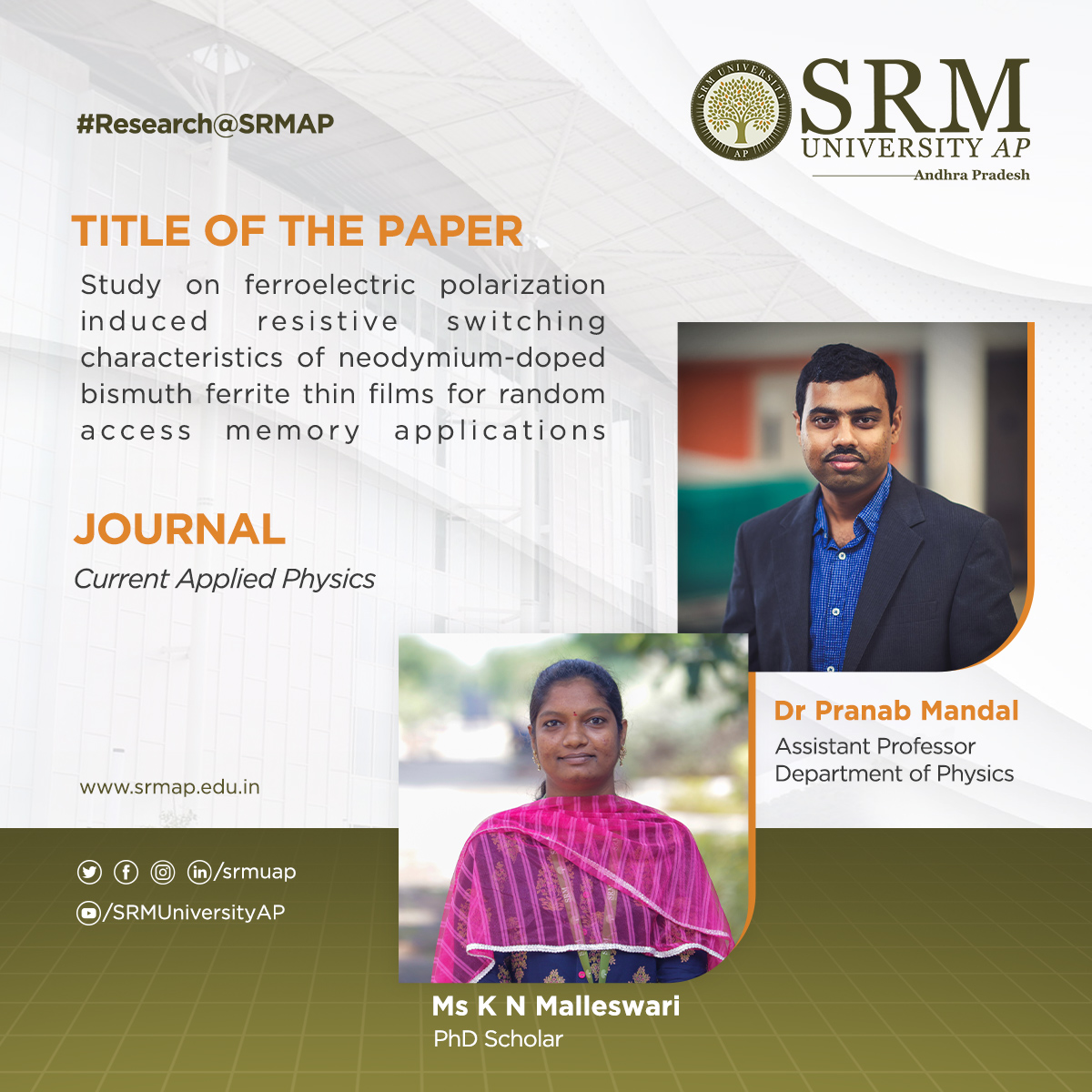 A paper titled “Study on ferroelectric polarization induced resistive switching characteristics of neodymium-doped bismuth ferrite thin films for random access memory applications” has been published by Dr Pranab Mandal, Assistant Professor of Physics and his PhD student, Ms K N Malleswari in the journal ‘Current Applied Physics’ having an Impact Factor of 2.480.
A paper titled “Study on ferroelectric polarization induced resistive switching characteristics of neodymium-doped bismuth ferrite thin films for random access memory applications” has been published by Dr Pranab Mandal, Assistant Professor of Physics and his PhD student, Ms K N Malleswari in the journal ‘Current Applied Physics’ having an Impact Factor of 2.480.Doi: https://doi.org/10.1016/j.cap.2022.04.013
Abstract
Resistive random-access memory (ReRAM) devices are based on the resistance switching (RS) effect. Such RS devices have recently attracted significant attention due to their potential application in realizing the next-generation non-volatile memory (NVM) devices. The present work reports on resistive switching (RS) characteristics of Neodymium (Nd)-doped bismuth ferrite (BFO) layers. The Nd (2–10 at%) doped BFO thin film layers were deposited using a spray pyrolysis method. The structural analysis reveals that a higher Nd doping concentration in BFO leads to significant distortion of the prepared Nd: BFO thin films from rhombohedral to tetragonal characteristics. The morphological analysis shows that all the deposited Nd: BFO thin films have regularly arranged grains. The X-ray photoelectron spectroscopy (XPS) analysis reveals that the prepared Nd: BFO thin films have a higher Fe3+/Fe2+ ratio and fewer oxygen vacancy (VO) defects which enrich the ferroelectric characteristics in Nd: BFO layers. The polarization-electric field (P-E) and RS characteristics of the fabricated Nd: BFO-based RS device were examined. It was observed that the Nd (7 at%) doped BFO RS device shows large remnant polarization (P r) of 0.21 μC/cm2 and stable RS characteristics.
Research in brief
Non-volatile resistive random access memory (RRAM) are future generation random access memory device with potential benefits such as high operational speed (nanoseconds read and write time), non-volatility, high endurance scalability and low power consumption [Namnoscale Research Lett., 15, 90, 2020]. Here in this work, we presented the resistive switching characteristics of a multiferroic material namely Nd-doped BiFeO3 material. The device shows stable resistive switching characteristics.
Practical implementation/social implications
Researchers in this field are focusing to overcome challenges of high operation current, lower resistance ratios, and reliability issues [Namnoscale Research Lett., 15, 90, 2020]. While several prototype RRAMs have been developed by other groups, future memory applications would require overcoming the challenges mentioned above.
Collaboration
The work has been conceptualized by Dr Amiruddin at Crescent Institute of Science and Technology, Chennai; and Dr Pranab Mandal and Ms Malleswari provided inputs on ferroelectric polarization – electric field (P – E) measurement and drafting.
Continue reading → - Interview mastery for global study opportunities June 13, 2022
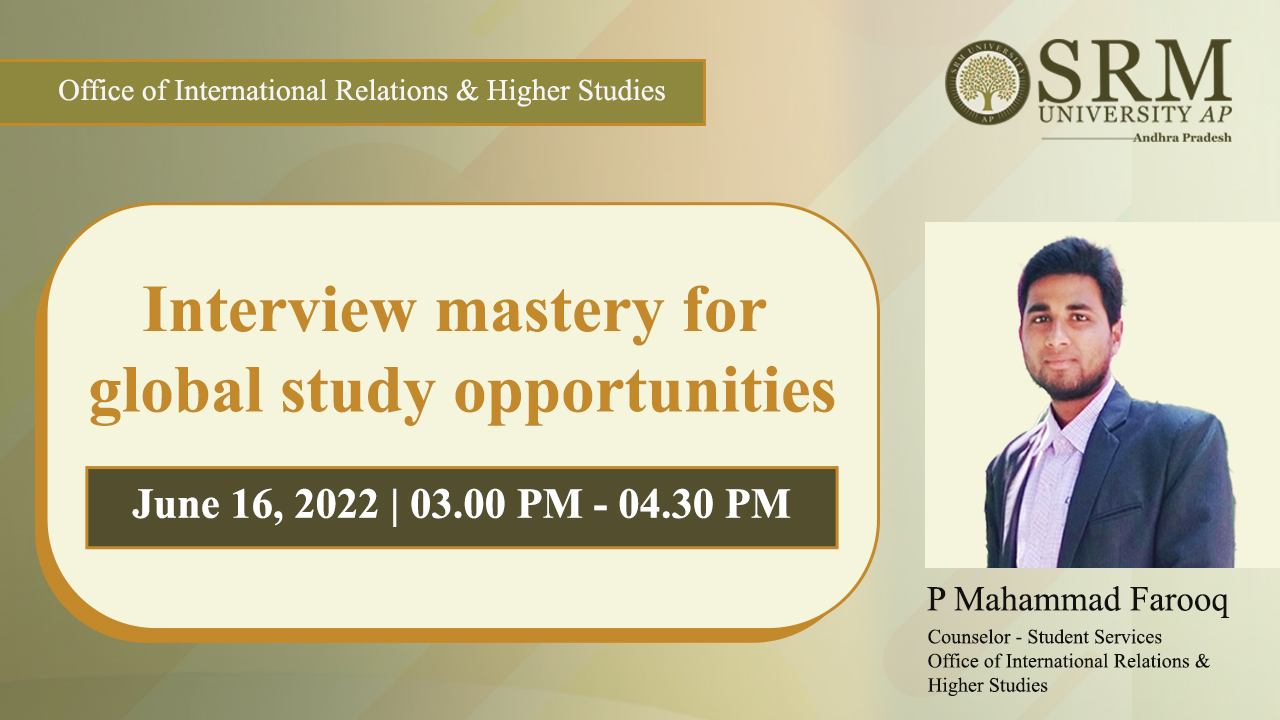 As you are aware, applying for international education can be daunting. Mastery of interview fundamentals is required to grab global study opportunities. Mr P Mahammad Farooq, Counselor- Student Services, Office of International Relations & Higher Studies, SRM University-AP, is conducting a session on the topic Interview Mastery For Global Study Opportunities on June 16, 2022, at 3.00 pm.
As you are aware, applying for international education can be daunting. Mastery of interview fundamentals is required to grab global study opportunities. Mr P Mahammad Farooq, Counselor- Student Services, Office of International Relations & Higher Studies, SRM University-AP, is conducting a session on the topic Interview Mastery For Global Study Opportunities on June 16, 2022, at 3.00 pm.The session aims to train students to respond to the interview questions, understand difficult interviewer personalities and showcase confidence that differentiates them from other candidates.
Avail this opportunity to sketch your study abroad pathway with the Office of International Relations and Higher Studies at SRM University-AP! Join the session on June 16, 2022, at 3.00 pm.
About the speaker
P.Md. Farooq is a well-known academician with more than five years of teaching, training research in the educational industry, and administrative experience. Before joining SRM University-AP, he was a freelance trainer for soft skills, career guidance coaching, advanced spoken English and employability skills. He expanded his academic boundaries by working at training institutions like the “Global talent track Pvt Ltd-Mumbai”, seventh sense solutions-Bangalore, Pygmalion Skills solutions Pvt Ltd-Bangalore, Rubicon Skill Development Pvt Ltd-Pune etc.
Continue reading → - Comparing organic food preferences of American and Indian consumers June 13, 2022
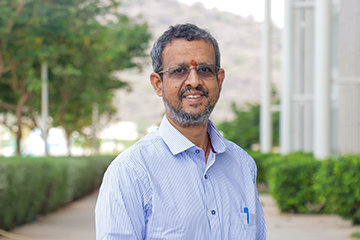
A paper titled “Organic food preferences: A comparison of American and Indian consumers” has been published by Prof Bharadhwaj Sivakumaran, Dean- SEAMS, SRM University-AP, Kirubaharan Boobalan (SSN College of Engineering), and Margaret Susairaj (Great Lakes Institute of Management, Chennai) in the journal Food Quality and Preference having an Impact Factor of 5.6.
This research tests a nomological model predicting organic food attitudes and purchase intentions in USA and India. Data were collected from India (n = 687) and the USA (n = 632) using Amazon M Turk and were analyzed using structural equation modelling and multi-group moderation technique. Results revealed that over and above attitude, subjective norm and perceived behavioural control, response efficacy and self-expressive benefits significantly affect consumers’ attitudes and purchase intentions toward organic food among American and Indian consumers. Findings reveal that response efficacy and attitude matter more in the USA while subjective norms and self-expressive benefits exert a greater influence in India. Therefore, marketers may reinforce belief-related elements while selling organic food products in the USA and societal-related elements while selling in India. Theoretically, this work adds to the Theory of Planned Behavior by adding self-expressive benefits and develops a common model for organic food across samples in USA and India.
Continue reading → - Food safety applications of surface-enhanced Raman Spectroscopy June 10, 2022
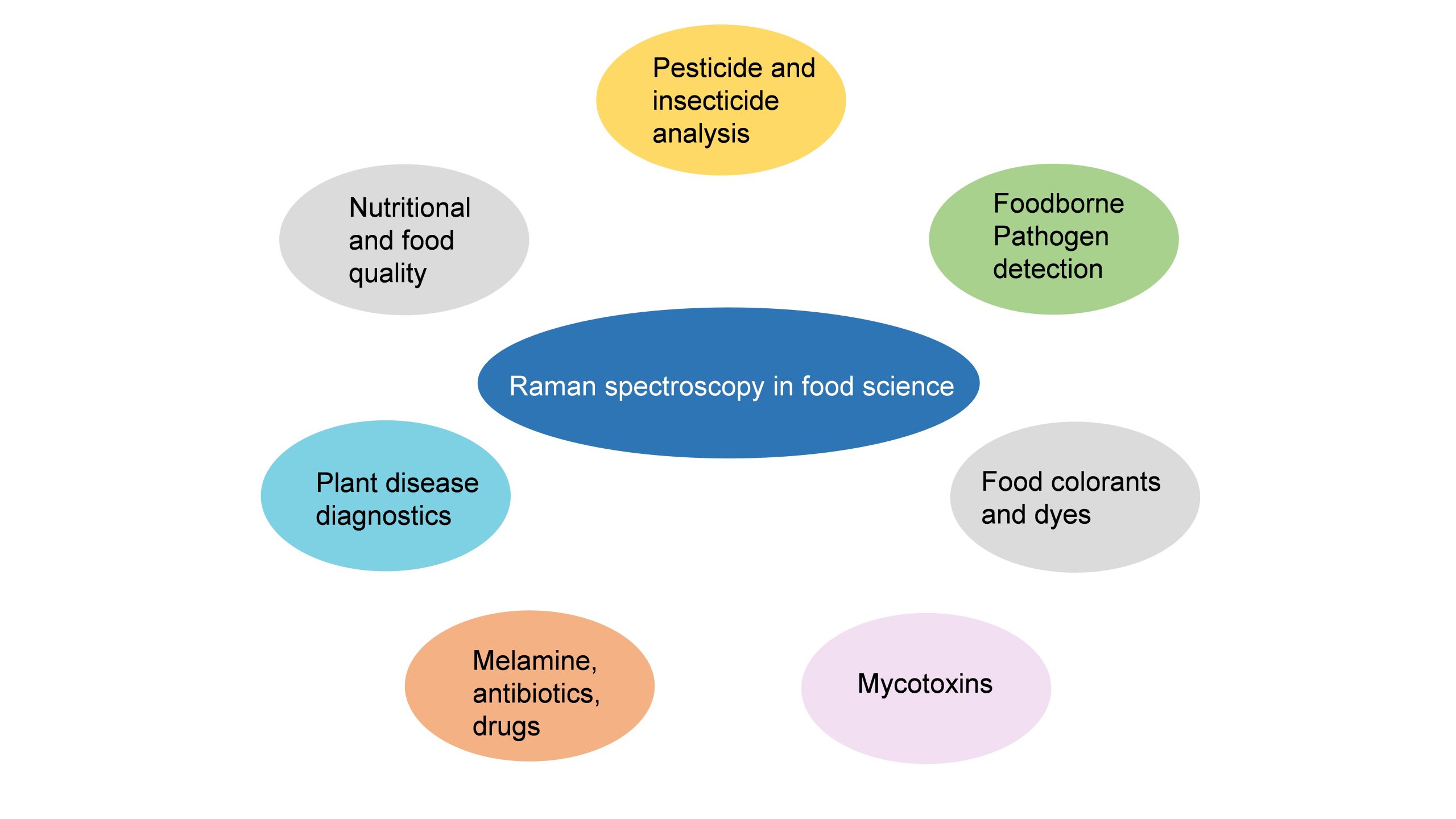
Surface-enhanced Raman Spectroscopy (SERS) is a nuanced chemical technique that amplifies the Raman scattering of molecules by utilising plasmonic nanostructured materials. SERS operates as a powerful detection tool that allows for the structural fingerprinting of a molecule. The ultra-high sensitivity and selectivity of the process offer it a vast array of applications in surface and interface chemistry, nanotechnology, biology, biomedicine, food science, environmental analysis and other areas.
Dr J P Raja Pandiyan and his PhD scholar, Ms Arunima Jinachandran from the Department of Chemistry have been keenly involved in exploring the possibilities of SERS technology in food science and other fields. The safety and quality concerns related to food were the primary reasons that impelled them to step into this domain. Their article “Surface-enhanced Raman spectroscopy for food quality and safety monitoring” was published in the book Nanotechnology Applications for Food Safety and Quality Monitoring, published by Elsevier. The article was published in collaboration with Dr Selvaraju Kanagarajan from the Swedish University of Agricultural Sciences.
Continue reading →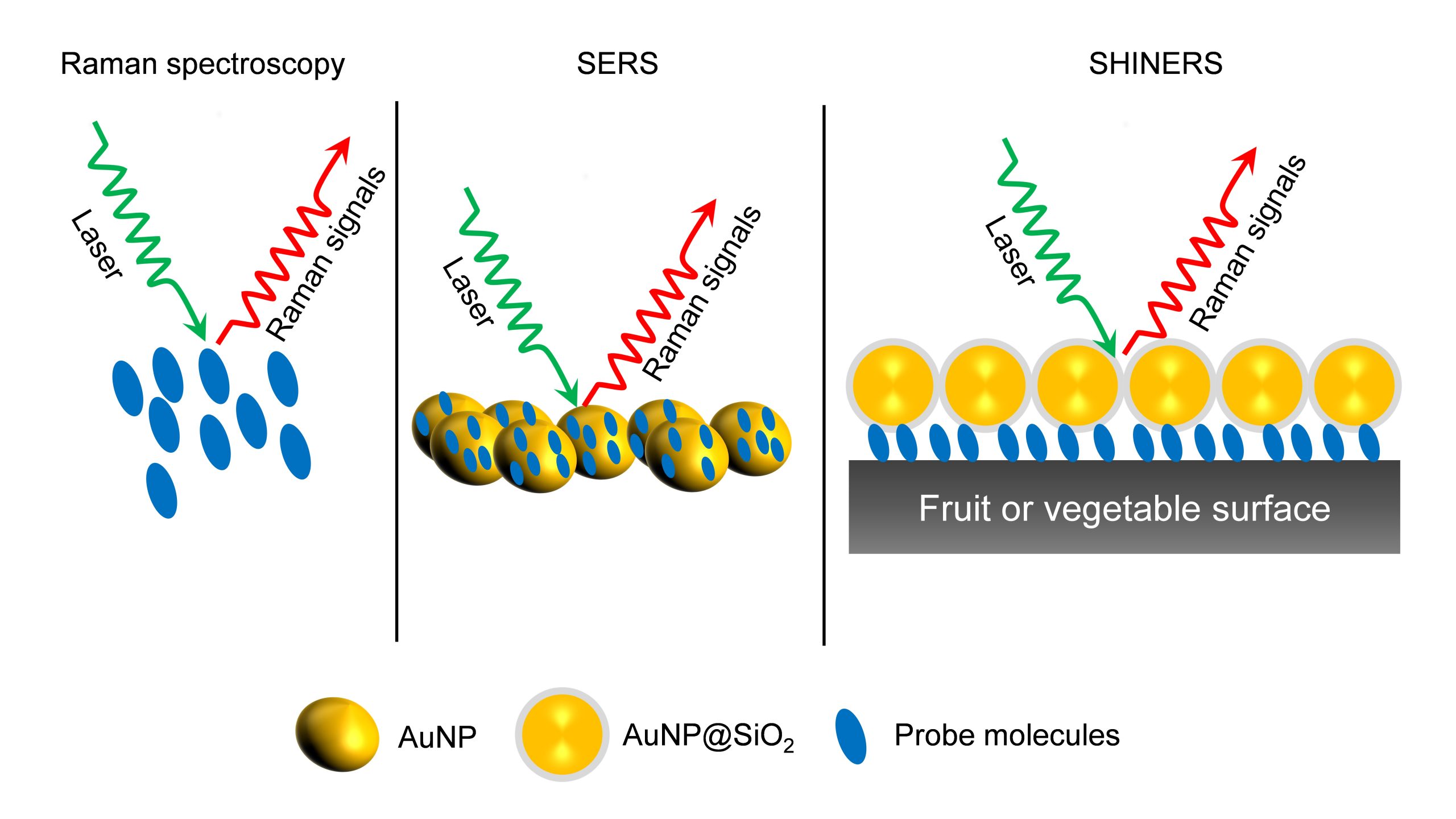 As an analytical technique, SERS possesses several advantages such as non-destructive, sensitive, and selective. In the chapter, the necessity, and applications of SERS in food science are elaborately discussed. They have also discussed all the possible food contaminants and how to identify them using SERS to ensure food quality. This book will serve as an enlightening read to research groups who are working on Raman, surface-enhanced Raman spectroscopy, analytical chemistry, and food quality analysis.
As an analytical technique, SERS possesses several advantages such as non-destructive, sensitive, and selective. In the chapter, the necessity, and applications of SERS in food science are elaborately discussed. They have also discussed all the possible food contaminants and how to identify them using SERS to ensure food quality. This book will serve as an enlightening read to research groups who are working on Raman, surface-enhanced Raman spectroscopy, analytical chemistry, and food quality analysis. - The pertinence of human activity recognition systems in the present era June 9, 2022
In recent years, human activity recognition has gained significant attention inside the scientific community. The enhanced spotlight is on the ground of its direct application in multiple domains. The latest research at the Department of Computer Science validates this assumption. Assistant Professor Dr V M Manikandan, and the 4th year B Tech Student Chaitanya Krishna Pasula have published a chapter titled An analysis of human activity recognition systems and their importance in the current era in the book Computational Intelligence Based Solutions for Vision Systems. The book is published by IOP Publishing Ltd.
Explanation of the chapter
 Human activity recognition is one of the most interesting and active research areas in computer vision. More research efforts are being put towards automatically identifying and analysing human activities due to their emerging importance in everyday applications. It serves applications in various areas like security video surveillance, smart homes, healthcare, human-computer interaction, virtual reality, robotics, and digital entertainment. Numerous papers have been published in the domain of human activity recognition. This book chapter discusses the various applications of human activity recognition, different methods available for automatic activity detection from videos, and the advantages of the human activity recognition system. It also describes the challenges in designing and implementing human activity detection schemes. Researchers further explain the publicly available datasets used for training and evaluating the systems for human activity recognition. The efficiency parameters used to evaluate the human activity recognition systems are also briefed in this chapter. The chapter is concluded by comparing the methodologies and speculating the possibilities of future research in this field.
Human activity recognition is one of the most interesting and active research areas in computer vision. More research efforts are being put towards automatically identifying and analysing human activities due to their emerging importance in everyday applications. It serves applications in various areas like security video surveillance, smart homes, healthcare, human-computer interaction, virtual reality, robotics, and digital entertainment. Numerous papers have been published in the domain of human activity recognition. This book chapter discusses the various applications of human activity recognition, different methods available for automatic activity detection from videos, and the advantages of the human activity recognition system. It also describes the challenges in designing and implementing human activity detection schemes. Researchers further explain the publicly available datasets used for training and evaluating the systems for human activity recognition. The efficiency parameters used to evaluate the human activity recognition systems are also briefed in this chapter. The chapter is concluded by comparing the methodologies and speculating the possibilities of future research in this field.In the future, the researchers are planning to design and implement an activity recognition system to identify abnormal activities in public places for safety purposes. This book chapter will be a helpful reference for UG/PG/Ph.D students who aspire to research in the domain of activity detection from video.
Continue reading → - An oil stove burning the waste oil: Innovation of the month June 9, 2022
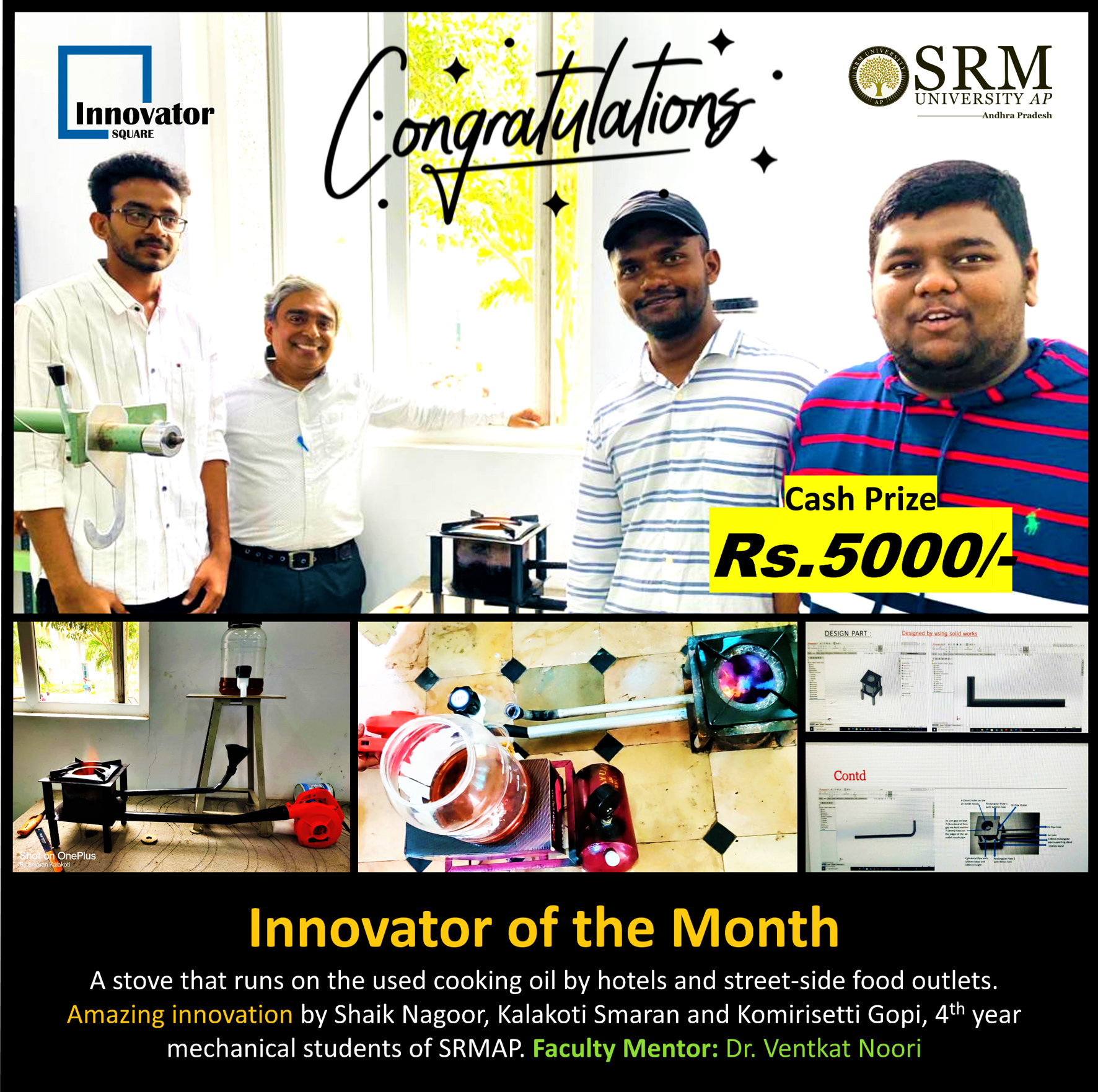
Innovation is seeing what everybody has seen and thinking what nobody has thought.
-Dr Albert Szent-Gyorgyi
The uncompromising vision to mould the students to be the leaders of tomorrow and to gear them up to think beyond the possible has been the propelling factor that drives each student of SRM University-AP to tread the unexplored paths and embrace the unseen challenges. They come out as transformed individuals, outgrown with enriching experiences, capable of introducing new changes into the world. Students are offered ample space and time to ideate, innovate, and build themselves into coming-of-age professionals.
Innovator Square is one such platform set up by the Entrepreneurship-cell to nurture innovative ideas and thoughts having the potential to be converted into a meaningful product or service. Each month, it brings out young talents who have expanded their limits to fashion out an unforeseen solution to the mundane troubles of society. The title winners of the ‘Innovator of the Month’ contest this time, are, Shaik Nagoor, Kalakoti Smaran, and Komirisetti Gopi, from the Department of Mechanical Engineering. They have designed a special stove that runs on used cooking oil.
Introducing innovations out of bits and pieces of the commonest of things adds value to our everyday lives. These budding masterminds deserve acknowledgement for their incredible solution to utilise the leftover oil. Cooking oil is a daily essential abundantly used in food processing industry, such as restaurants and fast food, as well as in households. Reusing the oil is found to have harmful effects as it contains carcinogenic substances, that may lead to cancer or other chronic health disorders. Hence the common practice followed is to dump it in open soil. However, this will affect soil fertility and a myriad of environmental concerns.
Their motive to offer a sustainable solution to this menace is what prompted them to devise a user-friendly stove that will consume the used cooking oil. This will also serve as a better alternative to LPG, saving up to 50% of the expenditure. The students expressed their happiness in having made their tiny share of contribution for the well-being of their society. They also thanked their faculty and the university for extending unswerving support to complete this project. “We can never thank enough Dr Venkata Nori sir for guiding and supporting us from the beginning of our project, he helped us achieve this innovation, we are also thankful to Mr Udayan Bakshi sir for helping us to build a start-up”, they remarked.
Continue reading → - Recasting high-entropy alloys for enhanced performance June 9, 2022
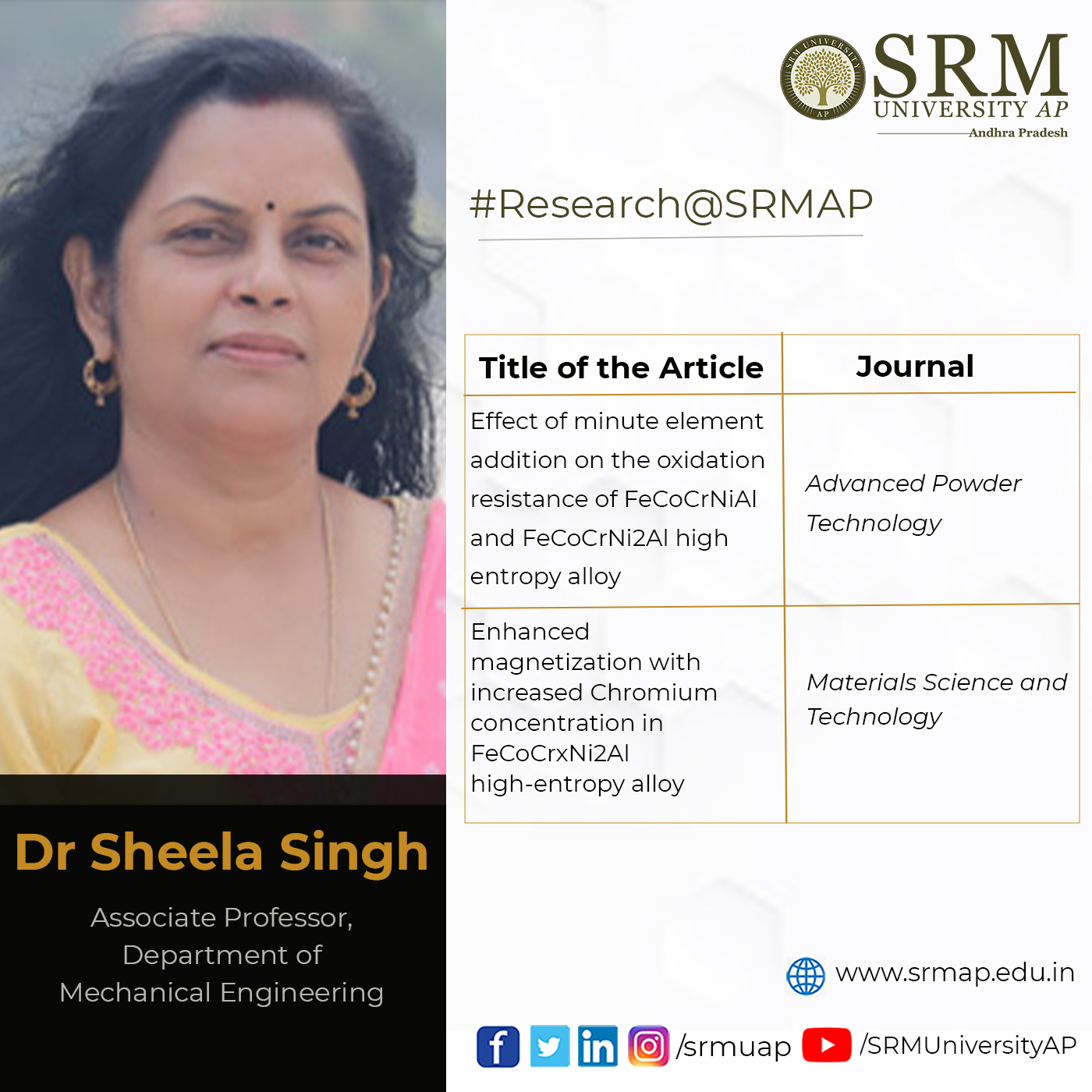
High-entropy alloys (HEAs) are gaining research significance in recent times as they propose novel alloy designs and concepts demonstrating better performance. HEAs constitute multiple principal elements in varying concentrations and combinations to produce new materials with excellent physical properties and superior performance at extreme temperature conditions. Recent studies have brought out a few high-entropy alloys possessing exceptional properties, even capable of challenging the existing theories and models for conventional alloys. However only very little has been explored within this multidimensional space leaving limitless possibilities to be explored and materialized.
Dr Sheela Singh, from the Department of Mechanical Engineering, has been conducting rigorous research in this domain and she has published research articles proposing novel ideas to tweak the properties of HEAs. In one of the articles co-authored by Dr Sheela, “Effect of minute element addition on the oxidation resistance of FeCoCrNiAl and FeCoCrNi2Al high entropy alloy”, published in the journal Advanced Powder Technology, she investigates the effect of Ti0.1 and Ti0.1Si0.1 addition on the high-temperature isothermal oxidation behaviour of dense FeCoCrNiAl and FeCoCrNi2Al high entropy alloys.
Mechanical properties such as hardness & young’s modulus, thermal properties such as melting temperature, specific heat capacity and coefficient of thermal expansion (CTE) were investigated by Nano hardness tester (NHT), differential scanning calorimetry (DSC) and dilatometer, respectively. The phases present in the HEAs produced by hot vacuum pressing and after isothermal oxidation were characterized by X-ray diffraction, Scanning Electron Microscopy and Raman Spectroscopy.
The weight gain recorded after isothermal oxidation for 5,25,50 and 100 hours at 1050°C was found to be parabolic in nature. X-ray diffraction analysis (XRD), as well as Raman spectroscopy analysis of HEA’s oxidized at 1050°C for 100 hours, shows the formation of the Al2O3 phase. A homogeneous thin oxide scale without any discontinuity was observed throughout the cross-section. It has been confirmed that Ti & Si addition in minute amount (0.1 at. % each) improves the mechanical properties and oxidation resistance as well as reduces the waviness of the oxide scale.
Another article co-published by her, “Enhanced Magnetization with Increased Chromium Concentration in FeCoCrxNi2Al High-Entropy Alloy”, in Materials and Science Technology, reports the effect of increasing the concentration of antiferromagnetic element Cr in FeCoCrxNi2Al (x = 0.5, 1.5) High Entropy Alloy (HEA) on their magnetic properties. It was found that the structure and composition of different phases, and the likely degree of spinodal decomposition in the Cr-Fe rich BCC phase significantly affects the magnetic properties.
Interestingly, the sample with Cr concentration x=1.5 showed two times larger saturation magnetization as compared to x=0.5. Furthermore, the magnetization versus temperature response shows a multi-phase character and exhibits distinct behaviour in low temperature and high-temperature regimes in both samples. The obtained soft ferromagnetic behaviour of these HEAs is crucial for the development of a new class of HEA for various applications.
The considerable structural and functional potential, as well as the richness of design, make HEAs promising candidates for new applications prompting further studies in the field. There remains a vast compositional space that is yet to be discovered. New studies have to be initiated finding out effective ways to recognise regions within this space where high-entropy alloys with potentially interesting properties may be lurking. Dr Sheela’s research is a right step in this direction to pave the way for fruitful developments in the future.
Continue reading → - Ameliorated Follow the Leader: Algorithm and Application to Truss Design Problem June 9, 2022
Q1 journal publications of our faculty members always bring honour to SRM University-AP. Dr Priyanka Singh, Assistant Professor from the Department of Computer Science and Engineering has published a paper titled “Ameliorated Follow the Leader: Algorithm and Application to Truss Design Problem” in the journal Structures (Q1 journal) having an impact factor of 2.983.
Abstract
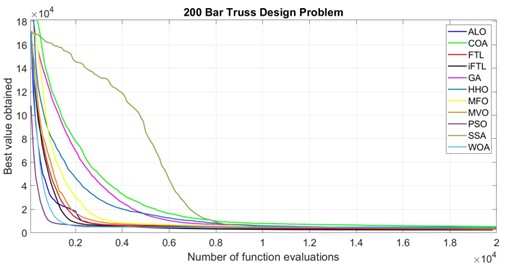 In the real world, resources, time, and money are always limited, necessitating the need for well-balanced algorithms. According to the “No-free-lunch” theorem, no single algorithm exists that works well in all applications. Hence, an optimisation algorithm with improved performance is always needed. The paper presents an improved follow the leader (iFTL) algorithm that imitates the behavioural movement of a sheep within the flock. The algorithm has been utilised to solve eight complex 10, 37, 52, 72, 120, 200, 224, and 942 bar truss design problems.
In the real world, resources, time, and money are always limited, necessitating the need for well-balanced algorithms. According to the “No-free-lunch” theorem, no single algorithm exists that works well in all applications. Hence, an optimisation algorithm with improved performance is always needed. The paper presents an improved follow the leader (iFTL) algorithm that imitates the behavioural movement of a sheep within the flock. The algorithm has been utilised to solve eight complex 10, 37, 52, 72, 120, 200, 224, and 942 bar truss design problems.Practical implications
The algorithm can be utilised to solve several structural and mechanical design problems such as bride design, antenna design, welded beam design, speed reducer, and many more. The algorithm is well suited for all types of real-life engineering problems where optimisation is required, from travel cost optimisation to optimisation of resources in the organisation under the given constraints and objective function.
Collaborators
1. Rahul Kottath (Computer Vision Engineer, Digital Tower, Bentley Systems India Private Limited, Pune, India)
2. Ghanshyam G. Tejani (Assistant Professor, Department of Mechanical Engineering, School of Technology, GSFC University, Vadodara, Gujarat, India)Future Research Plan
Currently, Dr Priyanka is exploring new engineering applications where optimisation techniques can be used. She is working on optimisation methods that can be utilised to classify microarray data, energy optimisation, and mechanical and structural design problems. In future, she plans to propose her work to the industrial level for the greater good and better solutions.
Continue reading →

